Inside The New York Botanical Garden
Wildlife
Posted in Wildlife on May 12 2010, by Plant Talk
Colorful Gems Spotted on Bird Walks During Spring Migration
 |
Debbie Becker leads a free bird walk at the Garden every Saturday from 11 a.m. to 12:30 p.m. beginning at the Reflecting Pool in the Leon Levy Visitor Center.
Photos of scarlet tanager and black-and-white warbler: Debbie Becker
|
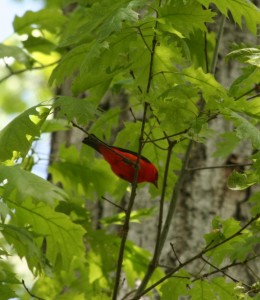 The spring bird migration is in full swing at the Garden. Recent bird walks have been a treat to the eyes and ears. Warblers are everywhere!
The spring bird migration is in full swing at the Garden. Recent bird walks have been a treat to the eyes and ears. Warblers are everywhere!
Warblers are small, colorful birds that migrate from areas of Central and South America to northern points in Canada and the United States. Once there, they build nests, reproduce, raise young, and then migrate back south in the fall.
Warblers are insect eaters and arrive just in time to feast on newly hatched insect larva. The warblers pass through the New York area mid-April to mid-May. Their beautiful songs and colorful feathers are enough to make any birder dizzy with delight.
This year searching for warblers is especially difficult because the trees bloomed earlier than usual due to the summer-like weather we had in April. With all the leaves on the trees, it is hard to find the songbirds as they dart about foraging for food. But diligence pays off. On our walks we’ve been treated to wonderful sightings, including the blackburnian warbler, a beautiful bird with an orange “fire throat.” All of the birders oohed and aahed as they strained their necks to see its throat—more orange than orange should be.
Read More
Posted in Wildlife on February 18 2010, by Plant Talk
Bird Watchers Witness Drama During Weekly Walk
 |
Debbie Becker leads a free bird walk at the Garden every Saturday from 11 a.m. to 12:30 p.m. beginning at the Reflecting Pool in the Leon Levy Visitor Center.
Photo of owls: Debbie Becker
|
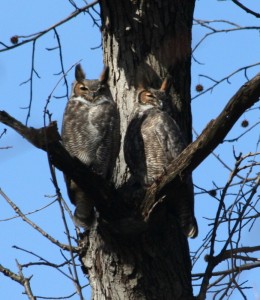 Late last month, in frigid weather conditions, 12 loyal birders met me under the clock at 11 a.m. for the weekly bird walk around the Garden. Our main objective was to see the nesting great horned owls. We headed over to the snag at the Forest’s edge where the owls successfully nested last year, and there in a cavity we saw our resident female owl, all fluffed up sitting, presumably, on eggs—only the top half of her body was visible.
Late last month, in frigid weather conditions, 12 loyal birders met me under the clock at 11 a.m. for the weekly bird walk around the Garden. Our main objective was to see the nesting great horned owls. We headed over to the snag at the Forest’s edge where the owls successfully nested last year, and there in a cavity we saw our resident female owl, all fluffed up sitting, presumably, on eggs—only the top half of her body was visible.
We then searched for the male owl, who usually is nearby, guarding the nest and his mate. Our binoculars scanned the bare branches of surrounding trees until we spotted him wedged between the trunk and a branch of a tree. Three blue jays were harassing him—screeching at the top of their lungs. When one jay got too close, the owl flew to a branch closer to us.
 As we stood there freezing and admiring his majestic beauty a red-tailed hawk flew in and landed about 20 feet away from the owl. This wasn’t any red-tailed hawk—it was the female that nested on the Library building last spring. She and her mate (he later died from eating a poisoned rat) had three offspring; she and her brood often can be seen flying around the Garden searching for prey. We had seen the female many times before, silently perched waiting for some unsuspecting squirrel or rabbit to happen by.
As we stood there freezing and admiring his majestic beauty a red-tailed hawk flew in and landed about 20 feet away from the owl. This wasn’t any red-tailed hawk—it was the female that nested on the Library building last spring. She and her mate (he later died from eating a poisoned rat) had three offspring; she and her brood often can be seen flying around the Garden searching for prey. We had seen the female many times before, silently perched waiting for some unsuspecting squirrel or rabbit to happen by.
Read More
Posted in Wildlife on February 5 2010, by Plant Talk
Owls on Nest Once Again, Waterfowl Add Color to Gray Days
 |
Debbie Becker leads a free bird walk at the Garden every Saturday from 11 a.m. to 12:30 p.m. beginning at the Reflecting Pool in the Leon Levy Visitor Center.
Photos: Debbie Becker
|
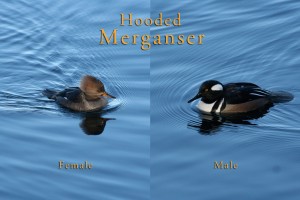 Winter holds its best birding in two areas: owls and ducks. Right now the great horned owls at NYBG are sitting on their nest ready to bring forth a new brood of owlets to delight and amaze us. Anticipated arrival time is the end of February. In the meantime, wander down to the Bronx River and observe the wonderful world of waterfowl on the river. Wood ducks, mallards, one farm duck, and several hooded mergansers have been present on the Bronx River. Ducks are fun to watch, and their brightly-hued feathers add color to gray winter days.
Winter holds its best birding in two areas: owls and ducks. Right now the great horned owls at NYBG are sitting on their nest ready to bring forth a new brood of owlets to delight and amaze us. Anticipated arrival time is the end of February. In the meantime, wander down to the Bronx River and observe the wonderful world of waterfowl on the river. Wood ducks, mallards, one farm duck, and several hooded mergansers have been present on the Bronx River. Ducks are fun to watch, and their brightly-hued feathers add color to gray winter days.
The mergansers can be seen diving under the water searching for small fish and insects. The male’s white crest becomes erect when danger is near or when trying to attract a female during mating season. The females sport a funky spiked hairdo, but their crests are burgundy and subtle. The males often bob their heads in territorial display and are silent most the time.
Read More
Posted in Science, Wildlife on January 20 2010, by Plant Talk
Project Looks to Catalog Six-Legged Residents and More
 |
Edgardo Rivera is Senior Curatorial Assistant in the William and Lynda Steere Herbarium. |
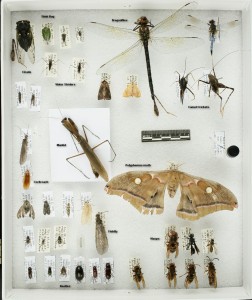 Many people walk through the Forest at NYBG in search of a break from the city and without concern for the names of the trees and flowers they encounter along the path. Others may stop occasionally to watch a passing chipmunk or to photograph the jewelweed. More tenacious individuals, armed with binoculars or perhaps a zoom lens on a camera, will specifically seek out the feathered denizens of the Forest but not many give a second look for the armored creatures that fly past them, the cold-blooded ones that slither under rotting logs, or the nocturnal beings that sit quietly under debris waiting for night to fall.
Many people walk through the Forest at NYBG in search of a break from the city and without concern for the names of the trees and flowers they encounter along the path. Others may stop occasionally to watch a passing chipmunk or to photograph the jewelweed. More tenacious individuals, armed with binoculars or perhaps a zoom lens on a camera, will specifically seek out the feathered denizens of the Forest but not many give a second look for the armored creatures that fly past them, the cold-blooded ones that slither under rotting logs, or the nocturnal beings that sit quietly under debris waiting for night to fall.
However, an effort to catalog these creatures is under way as part of the Garden’s Natural History project. Led by Jessica A. Schuler, Manager of the Forest, and Rob Naczi, Ph.D., Curator of North American Botany, the project has assembled specialists from different fields to identify the flora, fauna, and geography of the many habitats within the Forest.
Read More
Posted in Wildlife on January 12 2010, by Plant Talk
Two Species Normally Found in Spring Spotted on Bird Count
 Carol Capobianco is Editorial Content Manager at The New York Botanical Garden.
Carol Capobianco is Editorial Content Manager at The New York Botanical Garden.
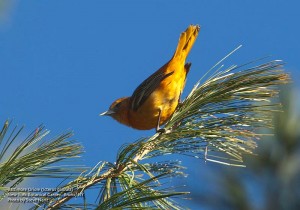 Local birder Rob Jett reports on his Web site The City Birder that two pine warblers and four Baltimore Orioles—bird species that at this time of year are usually much farther south (as in Florida and south of the border)—were recorded on December 27 at the Botanical Garden during the National Audubon Society’s annual Christmas Bird Count.
Local birder Rob Jett reports on his Web site The City Birder that two pine warblers and four Baltimore Orioles—bird species that at this time of year are usually much farther south (as in Florida and south of the border)—were recorded on December 27 at the Botanical Garden during the National Audubon Society’s annual Christmas Bird Count.
The Garden falls within the Bronx-Westchester count area, which this year marked its 86th season. (Roger Tory Peterson was one of the more famous participants.) This is the seventh time in the past 11 years that orioles (see photo at right, by Steve Nanz) were found in the count area, but four is a record high.
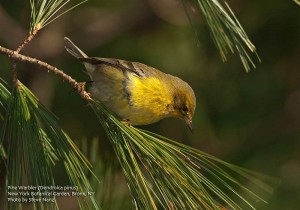 Debbie Becker, who leads the Garden’s weekly bird walks, has seen pine warblers (photo at left, by Steve Nanz) here since early December. And, she says that seeing orioles in December—often near the crabapple trees or the Rock Garden—has become more common. She has conducted her own “unofficial” bird count at the Garden in December for about 20 years. She thinks the sightings of birds such as orioles and warblers in winter may be the result of climate change, and some birds that usually migrate instead find a secure home with plenty of sustenance at the Garden.
Debbie Becker, who leads the Garden’s weekly bird walks, has seen pine warblers (photo at left, by Steve Nanz) here since early December. And, she says that seeing orioles in December—often near the crabapple trees or the Rock Garden—has become more common. She has conducted her own “unofficial” bird count at the Garden in December for about 20 years. She thinks the sightings of birds such as orioles and warblers in winter may be the result of climate change, and some birds that usually migrate instead find a secure home with plenty of sustenance at the Garden.
Read More
Posted in Wildlife on December 11 2009, by Plant Talk
 |
Debbie Becker leads a free bird walk at the Garden every Saturday from 11 a.m. to 12:30 p.m. beginning at the Reflecting Pool in the Leon Levy Visitor Center.
|
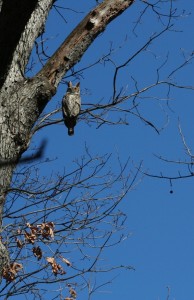 It’s that time of year again, when all the deciduous leaves have fallen and the bare tree limbs leave exposed the birds of the Forest. As you walk the Forest path you are reminded of the Native Americans who used the Forest as hunting grounds—along the trail by the Bronx River you will even pass the Bear Den, a cave believed to have been used by Native Americans while hunting.
It’s that time of year again, when all the deciduous leaves have fallen and the bare tree limbs leave exposed the birds of the Forest. As you walk the Forest path you are reminded of the Native Americans who used the Forest as hunting grounds—along the trail by the Bronx River you will even pass the Bear Den, a cave believed to have been used by Native Americans while hunting.
One of the most elusive figures in the NYBG Forest is the great horned owl, a large bird with tuft-like ears, cat-like eyes, and sharp claws. It is a monster of a bird, and it is the most sought-after species on our weekly walk.
Native Americans believed their deceased loved ones’ souls passed into the bodies of great horned owls. The owl was sacred to them and never hunted. Today we still hold the owl in reverence. It is a majestic, elusive creature that conceals itself in conifers during the day and hunts at night.
We’ll likely see this bird during our annual “unofficial” Christmas Bird Count tomorrow, in which we document the numbers of species and individual birds we see from 11 a.m. to 1 p.m. (The official Christmas Bird Count of the National Audubon Society, the 86th Bronx-Westchester Count, which includes the Botanical Garden, is on Sunday, December 27. Audubon conducts other counts over a three-week period all over North America and beyond.)
Read More
Posted in Science, Wildlife on September 24 2009, by Plant Talk
Cricket Crawl at the Garden Confirms Presence of These—and More
 |
Jessica Arcate is Manager of the Forest.
|
 |
Robert Naczi, Ph.D., is Curator of North American Botany.
|
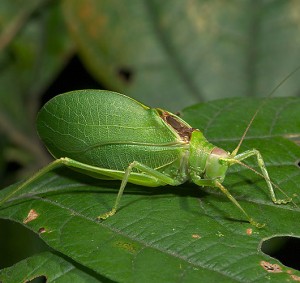 On the evening of Saturday, September 12, a fearless group of five naturalists outfitted with headlamps and recording equipment, ventured throughout the Botanical Garden to listen for seven species of crickets and katydids for the NYC Cricket Crawl.
On the evening of Saturday, September 12, a fearless group of five naturalists outfitted with headlamps and recording equipment, ventured throughout the Botanical Garden to listen for seven species of crickets and katydids for the NYC Cricket Crawl.
We were inspired to do the count, arranged by the U.S. Geological Survey (USGS) and others, after reading about the mystery of the “missing katydid of New York City.” It seems that in 1920, local naturalist William T. Davis reported the possible disappearance of the Common True Katydid (pictured here, Photo by ©MusicofNature.org) from Staten Island. Present-day experts on katydids and crickets surmised that katydids might be like the fabled canary in a coal mine, lost to environmental toxins, and so decided to organize the survey. Several species are common in the region and call at night with sounds easy to distinguish, permitting an observer to list the species present in an area just by listening to them. The Cricket Crawl promised to reveal patterns of biodiversity relevant to such matters as climate change, effects of deforestation, and adaptations of wildlife to urban areas.
Actually, we wondered why all the fuss about katydids? We knew we had them here at The New York Botanical Garden. As part of the efforts to document the natural history of NYBG, Edgardo Rivera and Robert Naczi had been studying insects at NYBG since mid-July. Because many insects find ultraviolet light (“black light”) irresistible, nocturnal collecting with a black light can be a very productive way of surveying local insect diversity. Edgardo and Rob had heard Common True Katydids at NYBG on several occasions, but came to realize their significance after reading announcements about the Cricket Crawl.
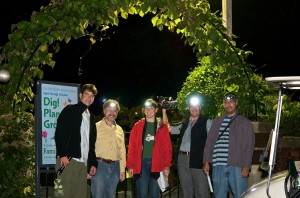 And so a team was assembled (see photo by Tom Andres) to confirm the identities of these insects for the Cricket Crawl: Edgardo Rivera (Senior Curatorial Assistant), Tom Andres (Herbarium volunteer), Kendrick Simmons (independent videographer), Jim Schuler (volunteer), and Jessica Arcate (Manager of the Forest). The evening began in the Perennial Garden and Ladies’ Border, and then headed to the knolls of the Arthur and Janet Ross Conifer Arboretum. At these sites four species were heard: Jumping Bush Cricket, Field Cricket, Greater Anglewing, and Common True Katydid. At the Mitsubishi Wetlands the fifth and last species of the night was added to the list, the Oblong-winged Katydid. Next, the team trekked into the center of the Forest. To our surprise one of the great horned owls from the Garden’s resident family was calling. The owl called several times from different trees, and it was incredible to hear. (To hear the sound of a great horned owl, click here.)
And so a team was assembled (see photo by Tom Andres) to confirm the identities of these insects for the Cricket Crawl: Edgardo Rivera (Senior Curatorial Assistant), Tom Andres (Herbarium volunteer), Kendrick Simmons (independent videographer), Jim Schuler (volunteer), and Jessica Arcate (Manager of the Forest). The evening began in the Perennial Garden and Ladies’ Border, and then headed to the knolls of the Arthur and Janet Ross Conifer Arboretum. At these sites four species were heard: Jumping Bush Cricket, Field Cricket, Greater Anglewing, and Common True Katydid. At the Mitsubishi Wetlands the fifth and last species of the night was added to the list, the Oblong-winged Katydid. Next, the team trekked into the center of the Forest. To our surprise one of the great horned owls from the Garden’s resident family was calling. The owl called several times from different trees, and it was incredible to hear. (To hear the sound of a great horned owl, click here.)
Read More
Posted in Programs and Events, Wildlife on September 3 2009, by Plant Talk
Join Debbie Becker in Looking for Early Migrants
 |
Debbie Becker leads a free bird walk at the Garden every Saturday from 11 a.m. to 12:30 p.m. beginning at the Reflecting Pool in the Leon Levy Visitor Center.
|
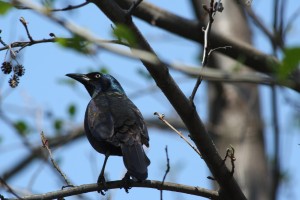 While the spring migration is exciting because of the colorful warblers that come through, the fall migration is much more spectacular in other ways. The warblers pass through again, but in drabber colors.
While the spring migration is exciting because of the colorful warblers that come through, the fall migration is much more spectacular in other ways. The warblers pass through again, but in drabber colors.
But it is the hawks, owls, harriers, ospreys, eagles, sparrows, swifts, swallows, and shorebirds on the move that attract most of the attention of bird watchers. The migration begins in late July, when the shorebirds begin showing up on coastal beaches. Osprey follow as they move south to open water. By mid-to-late August we see other species also migrating such as dragonflies and monarch butterflies. By September, the skies will be filled with their movement as well as of swifts and swallows.
As the last days of summer approach in mid-September and heat thermals rise off the Earth, the hawk migration will be in full swing. The hawks use the warm thermals to soar and conserve energy. A good thermal can allow a hawk to coast for miles. Broad-winged hawks are notorious for gliding on thermals in groups of thousands, known as “kettles,” during their migration from North America to South America.
Ruby-throated hummingbirds frequent the Garden during September as the jewelweed comes into bloom, filling their bellies with sweet nectar for the return trip to their wintering grounds. A hummingbird can fly nonstop up to 24 hours and almost 600 miles on stored fat.
Read More
Posted in Wildlife on June 25 2009, by Plant Talk
Find Them and Other Fledglings on Final Bird Walk of Season
 |
Debbie Becker leads a free bird walk at the Garden every Saturday from 11 a.m. to 12:30 p.m., September through June, beginning at the Reflecting Pool in the Leon Levy Visitor Center. This Saturday is her last of the season until September 5.
|
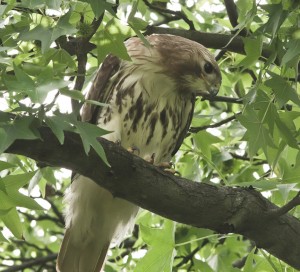 Summer—and all its activity—is just beginning for us, but this is the time when birds wind down. They began their busy season in February, in preparation for migration and nesting. They got ready for their long flight by eating more, a process called hyperphagia, so that they could go longer distances without stopping.
Summer—and all its activity—is just beginning for us, but this is the time when birds wind down. They began their busy season in February, in preparation for migration and nesting. They got ready for their long flight by eating more, a process called hyperphagia, so that they could go longer distances without stopping.
Now things have slowed for them. During the summer, though some species might have a second brood, for the most part the adults of many species, having reared their young, will be resting up for the fall migration back to their wintering grounds.
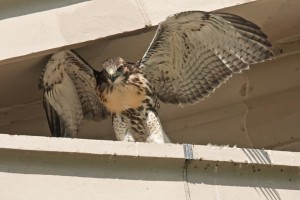 One adult pair here at the Garden—our nesting red-tailed hawks—have been kept active, however, with the successful fledging of their three babies. The siblings all took their first flight last week and can be seen hanging around the nest area—on the roof of the Library building, on nearby trees, and even on a bench, waiting for Mom and Dad to bring them food. But soon they will learn to hunt on their own.
One adult pair here at the Garden—our nesting red-tailed hawks—have been kept active, however, with the successful fledging of their three babies. The siblings all took their first flight last week and can be seen hanging around the nest area—on the roof of the Library building, on nearby trees, and even on a bench, waiting for Mom and Dad to bring them food. But soon they will learn to hunt on their own.
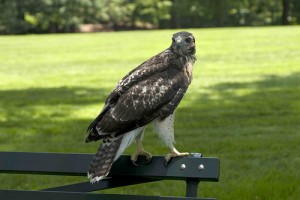 Come and look for the red-tailed hawk fledglings and other young birds on the final bird walk of the season. The walks will go on hiatus during July and August and return again September 5 in time for migration.
Come and look for the red-tailed hawk fledglings and other young birds on the final bird walk of the season. The walks will go on hiatus during July and August and return again September 5 in time for migration.
Top two photos by Richard Fleisher.
Posted in Programs and Events, Wildlife on May 29 2009, by Plant Talk
Spring Brings Special Sightings
 |
Debbie Becker leads a free bird walk at the Garden every Saturday from 11 a.m. to 12:30 p.m., beginning at the Reflecting Pool in the Leon Levy Visitor Center. The last one for the season will be June 27.
|
Three fuzzy heads can be seen bobbing up and down in the red-tailed hawk nest. Just like Central Park’s Pale Male and Lola, our red-tails have made a neat little “cliffside” home at the top of a structure—in this case the Library building. It is interesting to watch mom and pop fly in with food to feed the babies. The hawks’ diet consists mainly of small mammals (such as squirrels and chipmunks) and birds, keeping the balance of nature in check. The female red-tail seems to find mockingbirds a special treat and has resorted to robbing mockingbird nests. Recently, we saw the red-tail perched atop the Watson Building with a baby mockingbird in her talons and mother mocker desperately trying to get mother hawk to free her prey. The mocker aggressively attacked the hawk, but in the end the hawk had a meal for her babies and the mocker went home to an empty nest. It is the circle of life.
While searching for warblers in the Forest we were treated to a very rare sight at this time of year: Our well-hidden female great horned owl flew from her perch followed by her fledgling. We were able to follow the mature owl to a new perch but lost the young owl in the leaves. As we watched the mom settle in, she kept looking around for her baby. Suddenly she looked forward and began to hoot. Then she turned her head right and hooted and then left and hooted. I guess she heard the young owl reply, because she closed her eyes and seemingly went to sleep.
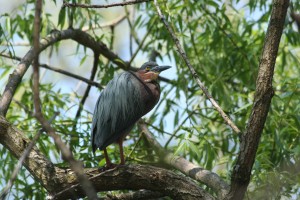 As the warbler numbers begin to dwindle, the birds having moved on to northern climes, we are grateful for another wonderful migration. Most of us were treated to the sightings of warblers such as black-throated blue, black-throated green, northern parula, Tennessee, chestnut-sided, bay-breasted, American redstart, common yellowthroat, yellow, prothonotary, and ovenbird. We also had warbling, red-eyed, and blue-headed vireos and a long list of other spectacular birds: Baltimore oriole, scarlet tanager, rose-breasted grosbeak, wood thrush, veery, hermit thrush, gray catbird, brown creeper, house wren, rough-winged swallow, bank swallow, tree swallow, chimney swift, eastern kingbird, great blue heron, great egret, night-heron, green heron (in full breeding plumage, see above photo, courtesy Debbie Becker), cormorant, wood duck (adults with 11 babies), mallard (adults with 12 babies) indigo bunting, cedar waxwing, savannah sparrow, ruby-throated hummingbird, eastern towhee, and northern flicker.
As the warbler numbers begin to dwindle, the birds having moved on to northern climes, we are grateful for another wonderful migration. Most of us were treated to the sightings of warblers such as black-throated blue, black-throated green, northern parula, Tennessee, chestnut-sided, bay-breasted, American redstart, common yellowthroat, yellow, prothonotary, and ovenbird. We also had warbling, red-eyed, and blue-headed vireos and a long list of other spectacular birds: Baltimore oriole, scarlet tanager, rose-breasted grosbeak, wood thrush, veery, hermit thrush, gray catbird, brown creeper, house wren, rough-winged swallow, bank swallow, tree swallow, chimney swift, eastern kingbird, great blue heron, great egret, night-heron, green heron (in full breeding plumage, see above photo, courtesy Debbie Becker), cormorant, wood duck (adults with 11 babies), mallard (adults with 12 babies) indigo bunting, cedar waxwing, savannah sparrow, ruby-throated hummingbird, eastern towhee, and northern flicker.
Read More

 The spring bird migration is in full swing at the Garden. Recent bird walks have been a treat to the eyes and ears. Warblers are everywhere!
The spring bird migration is in full swing at the Garden. Recent bird walks have been a treat to the eyes and ears. Warblers are everywhere!

















